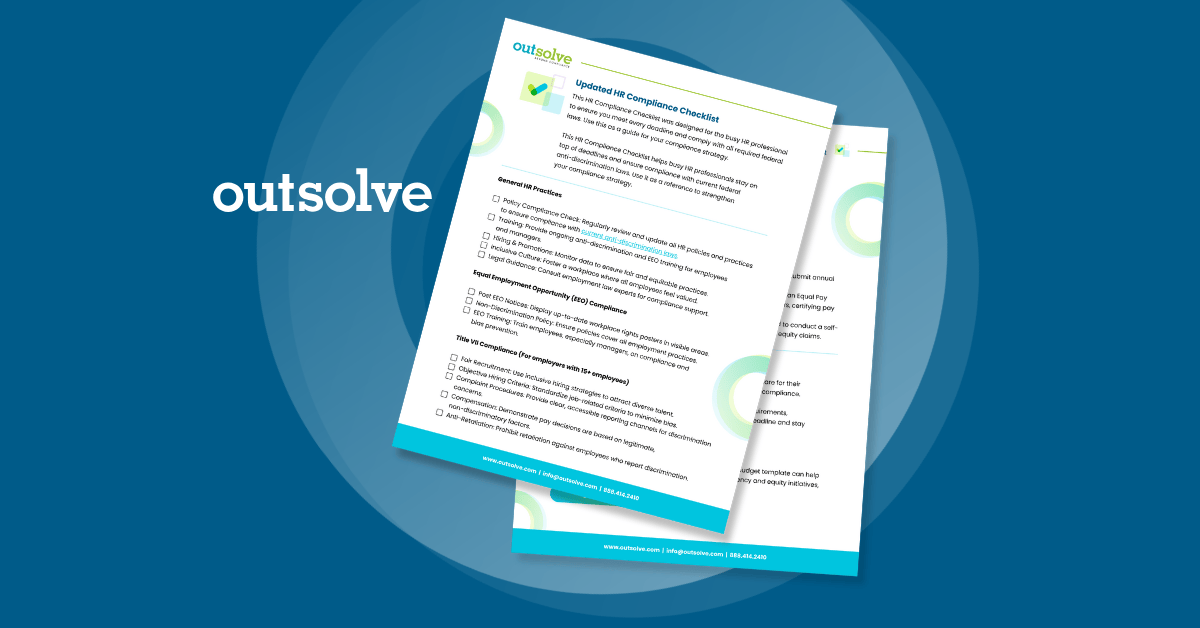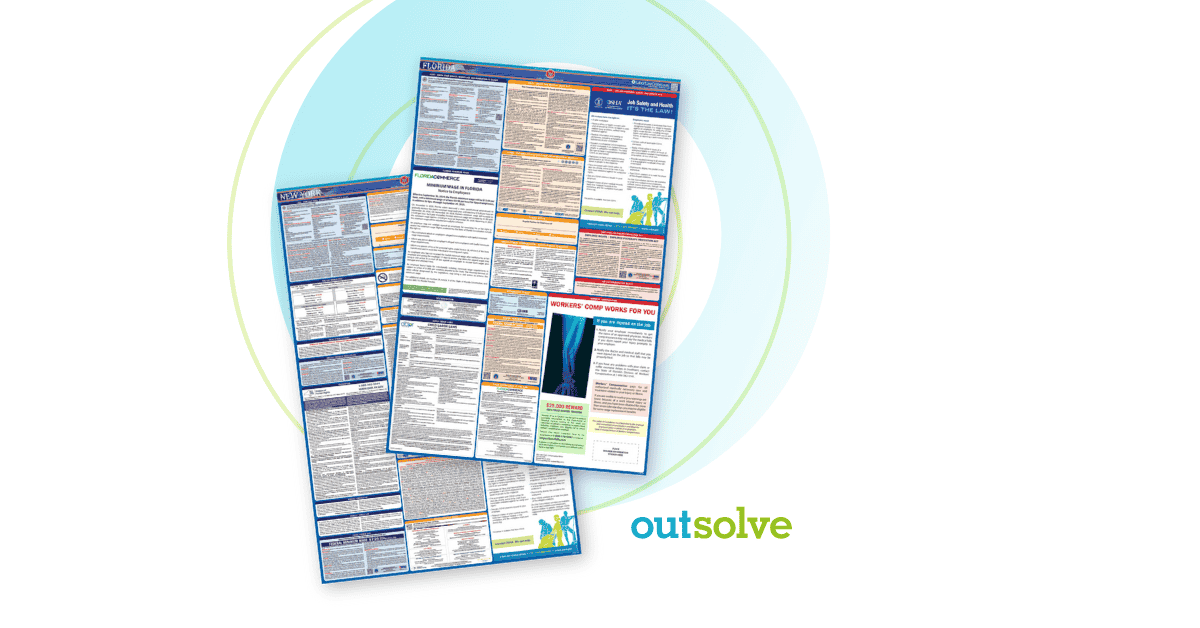4 min read
How to Achieve Compliance in HR: What You Need to Know
 Charlotte Mendoza, SHRM-CP
:
Apr 7, 2025 11:56:27 AM
Charlotte Mendoza, SHRM-CP
:
Apr 7, 2025 11:56:27 AM

State pay reporting. Anti-discrimination. Workplace Safety. AI in Hiring.
Sound familiar? These are just a few of the HR compliance obligations HR professionals face on a daily basis. Complying with these laws is more important than ever. Keeping up with these laws is getting harder and harder.
Things are changing when it comes to employment law on a regular basis, which can make achieving compliance in HR challenging. New laws are emerging that can make staying compliant as easy as finding a needle in a haystack.
HR compliance isn’t just about avoiding penalties, it’s about fostering a workplace culture that prioritizes fairness, accountability, and legal integrity. A proactive approach to compliance helps organizations mitigate risk while strengthening trust among employees.
 Key Areas of HR Compliance
Key Areas of HR Compliance
To build and maintain a compliant workplace, HR teams must focus on several core areas simultaneously. Each area is comprised of multiple laws and requirements for HR compliance. Here are just a few:
1. Employment Law & Anti-Discrimination Protections
HR professionals must ensure that hiring, promotion, and workplace policies align with key federal laws, including:
- Title VII of the Civil Rights Act – Required for employers with 15 or more employees and prohibits discrimination based on race, color, religion, sex, and national origin. Employers must ensure objective hiring criteria, compliant procedures, fair pay, and anti-retaliation.
- The Americans with Disabilities Act (ADA) – Required for employers with 15 or more employees and compels them to provide reasonable accommodations for employees with disabilities. This can look like engaging with your employee about their accommodation need, conducting an audit to ensure workplace and online tools are disability friendly, and training managers on handing requests.
- The Age Discrimination in Employment Act (ADEA) – Required for employers with 20 or more employees and protects workers over 40 from age-based discrimination. This applies to performance reviews, layoff criteria, benefits plans, and succession planning.
- State & Local Laws – Many states have expanded protections beyond federal requirements, making it critical to stay informed on state-level regulations. California, Illinois, and Massachusetts all require some type of state pay data reporting. Subscribe to OutSolve’s blog to stay updated as these laws are enacted and change frequently.
2. Wages & Hour Laws
Ensuring fair pay practices is a cornerstone of compliance. Compliance benchmarking and pay equity audits are two things that can be done to evaluate your pay practices and ensure all employees, regardless of their gender, race, or other protected characteristic, are paid fairly. Key considerations include:
- Fair Labor Standards Act (FLSA) – Governs minimum wage, overtime pay, and recordkeeping requirements.
- Pay Transparency Laws – More and more states require employers to disclose salary ranges in job postings and report pay equity data. For a complete list, check out our Ultimate Guide to State Pay Transparency Law Guide.
- Equal Pay Act – Prohibits sex-based wage discrimination between genders who perform the same job.
3. Workplace Policies & Employee Rights
Maintaining clear, legally sound policies helps prevent disputes and ensures employees understand their rights. HR teams should regularly review:
- Harassment & Discrimination Policies – To align with EEOC guidance and foster a respectful workplace, harassment and discrimination policies and training should be regularly updated and required.
- Remote & Hybrid Work Policies – To ensure compliance with labor laws and state regulations for remote employees, you should regularly review these laws. States will enact their own legislation for pay transparency, minimum wage, and much more and you are required to follow each state’s individual law where you have employees working.
- Family & Medical Leave Act (FMLA) Compliance – Employers must provide eligible employees with job-protected leave under federal or state laws.
4. Federal Contractor Compliance
Organizations that hold federal contracts must meet certain additional compliance requirements. Changes are happening fast to what once was affirmative action compliance, but there are many requirements that are still in effect, such as:
- Section 503 of the Rehabilitation Act – Requiring outreach efforts to recruit individuals with disabilities.
- VEVRAA (Vietnam Era Veterans’ Readjustment Assistance Act) – Setting hiring benchmarks for protected veterans.
5. AI & Technology in Hiring
As HR teams adopt AI-driven hiring tools, compliance considerations are growing. Some states now require:
- Bias Audits – To ensure AI tools do not discriminate based on protected characteristics.
- Transparency in Automated Decisions – Requiring employers to disclose when AI is used in hiring.
Staying informed about evolving AI regulations will be critical in the coming years.
Best Practices for How to Achieve Compliance in HR
HR compliance is not a one-time task, it requires ongoing monitoring and adjustment to ensure you are meeting every deadline and following every law.
Some best practices HR teams should incorporate are:
- Regular Policy Audits – Review and update HR policies and employee handbooks to align with new laws and regulations.
- Employee & Manager Training – Ensure teams understand compliance responsibilities, particularly around anti-discrimination and wage laws.
- Accurate Recordkeeping – Maintain proper documentation for hiring, wages, benefits, and employee relations.
- Expert and Legal Consultation – Engaging with lawyers or partnering with experts like OutSolve can help your HR team navigate complex and changing regulations.
What Achieving HR Compliance Means for your Organization
Achieving HR compliance requires the right balance of legal knowledge, proactive planning, and clear communication. By staying up-to-date with employment laws, reinforcing fair workplace policies, and ensuring transparency in decision-making, HR professionals can protect their organizations while fostering a positive, legally compliant work environment.
OutSolve knows these are interesting times in the HR space. To help you and your team stay on track and simplify compliance mandates, OutSolve created an HR Checklist. This checklist is laid out in an easy-to-read format with topic headers and the required tasks associated for what you need to do.
By going through this checklist, you are helping to reduce risk associated with non-compliance, setting your organization up for success for years to come. You can ensure your team is staying proactive and updated on the latest regulations and requirements.
This checklist also helps HR professionals get some time back in their day. We have pulled all the important topics and laws of HR compliance into one document making it easy for your team to go through the list and see what you need to do.
If you would like further assistance with your HR compliance needs like guidance on anti-discrimination laws, pay audit help, state pay reporting assistance, and more, contact OutSolve and our consults will be there to guide you during every step of your HR compliance journey.
Charlotte supports the California office and oversees the team's projects as well as her own. She has a Bachelor's Degree in Communications from California State University, Sacramento, and holds a SHRM-CP certification. Charlotte has more than eleven years of experience in the field of Non-Discrimination Planning and HR compliance for companies ranging in size. She has developed and presented web-based and on-site training to various audiences ranging from Executive level to recruitment and HR staff.
Recent Posts
Related Posts

The Ultimate Guide to Multi-State Labor Law Posters
Human Resources professionals understand how important and challenging it can be to remain updated and compliant with labor laws. This is especially...

Countdown: Final Days of the 90-Day Safe Harbor Period for AAPs
April is here and with that comes the end of the 90-day safe harbor period for federal contractors complying with EO 11246. As April 21, 2025,...

What Triggers an I-9 Audit? Key Factors You Should Know
Verifying proper identity and work authorization documentation for every employee is a crucial HR compliance function - not just for a company’s...



